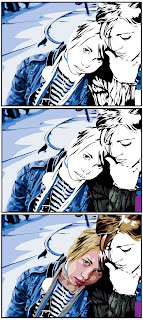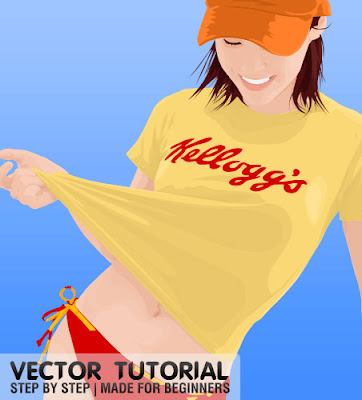Kamis, 29 November 2007
Rabu, 28 November 2007
Vector Myspace Theme Tutorial

Designing A Texture
 Because fonts can be easily outlined in vector format, we have the freedom to transform a character into an object, and further into a group of objects, scale it without limit. Grouped, overlapped, and layered, typefaces can become in themselves, a texture at times, worthy of exploring as a designer, and there are plenty of textured fonts out there, completely free. Continue
Because fonts can be easily outlined in vector format, we have the freedom to transform a character into an object, and further into a group of objects, scale it without limit. Grouped, overlapped, and layered, typefaces can become in themselves, a texture at times, worthy of exploring as a designer, and there are plenty of textured fonts out there, completely free. Continue
Imitating A Scanner Darkly
 Using Illustrator's pencil tool and shapes of solid color, you can imitate the graphic novel styling of A Scanner Darkly. An animator from the film shows us how.
Using Illustrator's pencil tool and shapes of solid color, you can imitate the graphic novel styling of A Scanner Darkly. An animator from the film shows us how. Designing Logo In Illustrator
It should be noted that the example provided here was done mostly for this tutorial and I have bypassed a few of the earlier stages of logo design and concepting such as thumbnail sketching, etc.
The logo is for a company called stone gecko, so I thought an illustration of a chameleon/gecko type animal would be good. Part of the concept originanlly was to make the gecko"s lines apear blocky or stone like, but the process began to go out of the scope of this tutorial so I opted for a more simplified approach.
This tutorial assumes you have at least a basic working knowledge of Illustrator, for example you should know how to select objects and change their outlines and fills. Being comfortable with the pen tool is also a big plus. Go to tutorial page
Vector Tutorial
 View the tutorial : www.vectorportraits.com This is a step-by-step guide on creating your own vector portraits using Photoshop. Site also features a gallery so you can upload a vector that you finished after reading the tutorial. I really hope that this tutorial could help those who want to start with vectoring photos.
View the tutorial : www.vectorportraits.com This is a step-by-step guide on creating your own vector portraits using Photoshop. Site also features a gallery so you can upload a vector that you finished after reading the tutorial. I really hope that this tutorial could help those who want to start with vectoring photos.
What is vector art?
What is vector art?
In the truest most pure form, vector art is art made up of points, lines and curves and represented by mathematical equations as opposed to ‘mapped pixels’ as in a raster or bitmap file. Vector art is resolution independent, meaning that it can be scaled to any size and retain its sharpness and detail at no loss in quality.
Vector illustration is most commonly done in programs such as Adobe Illustrator, Macromedia Freehand, Flash, and CorelDRAW. Vectors in these programs (at the hands of skilled artists and draftsmen) can achieve a nearly photo-like quality or be beautifully abstract.
There is usually a distinct feel and appearance to common vector illustration which seems to be growing in popularity amongst many of the art communities today.
Recognizes a couple logical divisions of the Vector Art movement, and these are the following:
1. Pure Vector – This is any illustration that is created entirely in a vector illustration environment/application such as Adobe Illustrator. Photos or images may have been initially modified in a raster program but then exported as ‘paths’ to the vector program, so basically in the end the vector file contains no raster images whatsoever.
2. Vector Dominant Hybrid – This broad category is commonly for the commercial designer or artist who uses type and vector elements largely in a document but may use photo textures or other small raster ‘embellishments’. In order for a piece to qualify as a Vector Dominant Hybrid it must be comprised of no less than 70 percent vector objects.
3. Vector Style - This particular style is perhaps more common than purist vector art, and in some cases is what was commonly and most inappropriately termed as the ‘Trend Whore’ style. These works are usually created in Photoshop (a raster editing program – now with ‘loosely termed’ vector support) and appear to ‘look’ like true vectors. Even though the final file format may not be that of a purely vector work, the look and the elements are there and by and large will be accepted here, though some restrictions may apply and will be handled on a submission by submission basis.









